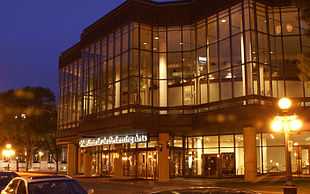Ordway Center for the Performing Arts
| Ordway Music Theater | |
 | |
| Address |
345 Washington Street St. Paul, Minnesota United States |
|---|---|
| Coordinates | 44°56′41″N 93°05′54″W / 44.9448°N 93.0982°WCoordinates: 44°56′41″N 93°05′54″W / 44.9448°N 93.0982°W |
| Capacity |
Music Theater: 1,900 Concert Hall: 1,093 |
| Construction | |
| Opened | January 1, 1985 |
| Architect | Benjamin C. Thompson |
| Website | |
|
www | |
Ordway Center for the Performing Arts is located in downtown Saint Paul, Minnesota and hosts a variety of performing arts, such as touring Broadway musicals, orchestra, opera, and cultural performers. It serves as a home to several local arts organizations, including the Minnesota Opera, The Saint Paul Chamber Orchestra, and The Schubert Club. James Rocco is currently the center's Vice President and Producing Artistic Director.
History
In 1980, Saint Paul resident Sally Ordway Irvine (3M heiress and arts patron) dreamed of a European-style concert hall offering “everything from opera to the Russian circus.” Sally contributed $7.5 million—a sum matched by other members of the Ordway family—toward the cost of the facility. Fifteen Twin Cities corporations and foundations were the principal funders of the $46 million complex, then the most expensive privately funded arts facility ever built in the state. The internationally known architect (and Saint Paul native) Benjamin Thompson, whose other projects included the Faneuil Hall renovation in Boston and South Street Seaport in New York, was selected to design a building that would project “a visible contemporary image” but would also fit harmoniously on a site facing Rice Park, a block-square park framed by historic buildings. As designed by Thompson, Ordway Center (originally named Ordway Music Theatre) contains the Music Theater (1,900 seats); an intimate McKnight Theatre (306 seats); two large rehearsal rooms; and the Marzitelli Foyer, a spacious two-story lobby with a glass curtain-wall through which theater-goers enjoy a sweeping panorama of Rice Park, its surrounding buildings, and in the distance, the Mississippi River. The McKnight Theatre was torn down in 2013 to make room for the new 1,093 seat Concert Hall which opens in March 2015.
Ordway Center opened its doors to the public on January 1, 1985 as Ordway Music Theatre. The name was changed in 2000 to reflect the vast array of performing arts that take place under its roof.
Today Ordway Center for the Performing Arts is recognized as one of the nation’s leading not-for-profit performing arts centers serving 400,000 people annually with nearly 500 performances. It is home to a wide variety of performances that encompass the finest in musical theater, children’s theater, world music and dance, orchestra, opera, and recitals.
About the building
Ordway Center contains the 1,900 seat Music Theater, the 1,100 seat Concert Hall, two large rehearsal halls, and magnificent lobbies on each floor, including the second floor Marzitelli Foyer, a spacious, two story lobby encircled by a glass facade.
| Architect | Benjamin Thompson and Associates |
| Contractor | McGough Construction |
| Building Area | 160,000 square feet (15,000 m2) |
| Site Area | 90,000 square feet (8,400 m2) |
| Lobby & Grand Foyer Area | 38,000 square feet (3,500 m2) |
| Back of House Area | 22,000 square feet (2,000 m2) |
| Rehearsal Room Area | 4,800 square feet (450 m2) |
Interior
| Woodwork (public areas) | Honduran mahogany |
| Original Carpet | Designed by Benjamin Thompson and Associates. 6,000 square yards, manufactured by Mohawk Mills, Greenville, Mississippi |
| Lobby Tile | Imported from Wales, United Kingdom |
| Chandeliers | Twelve total: handcrafted chimneys from West Virginia; brass bases from Winona Studio Lighting, Winona, Minnesota |
| Lobby & Grand Foyer Area | 38,000 square feet (3,500 m2) |
Exterior
| Main Façade | Copper-clad exterior window and fascia system, with more than 500 insulated glass panels. |
| Brickwork | Handmade brick by Kane Gonic Brickworks of Gonic, New Hampshire. Each brick has variation in color and texture for a rich, handcrafted texture. |
| Brick pattern | Flemish Bond. Pattern: Two “stretchers” laid lengthwise, one “header” laid crosswise. |